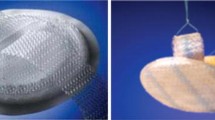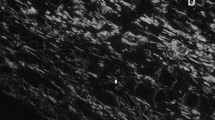Abstract
Despite the recognized advantage of surgical meshes in abdominal hernia repair, reports of long term complications after implantation are increasing. 25 chronic hernia rats underwent incisional repair (n = 5/mesh group) with compressed poly(tetra-fluoro-ethylene) (cPTFE), expanded poly(tetra-fluoro-ethylene) (ePTFE), polypropylene (PP), poly(ethylene-terephtalate) + collagen (PET + C), and porcine intestinal submucosa (SIS). At 30 days, the extent and strength of intra-abdominal adhesions was evaluated, along with tissue-mesh integration, material shrinkage, and inflammatory response. The extent and tenacity of adhesions were reduced in PET + C and SIS, while tissue contraction was largely reduced in the presence of cPTFE. The tissue integration was not affected by composition or material construction. The host tissue response was elevated and arrested in a chronic imflammatory phase in the presence of PET + C and SIS, and resolved in the case of cPTFE. The different composition and material construction did not affect significantly the overall performance of the evaluated surgical meshes, apart from PP.




Similar content being viewed by others
References
Cobb WS, Burns JM, Peindl RD, et al.: Textile analysis of heavy weight, mid-weight, and light weight polypropylene mesh in a porcine ventral hernia model. J Surg Res. 2006;136:1–7.
Greca FH, Souza-Filho ZA, Giovanini A, et al. The influence of porosity on the integration histology of two polypropylene meshes for the treatment of abdominal wall defects in dogs. Hernia. 2008;12:45–9.
Greca FH, de Paula JB, Biondo-Simoes ML, et al. The influence of differing pore sizes on the biocompatibility of two polypropylene meshes in the repair of abdominal defects. Experimental study in dogs. Hernia. 2001;5:59–64.
Klinge U, Schumpelick V, Klosterhalfen B. Functional assessment and tissue response of short- and long-term absorbable surgical meshes. Biomaterials. 2001;22:1415–24.
Klosterhalfen B, Klinge U, Schumpelick V. Functional and morphological evaluation of different polypropylene-mesh modifications for abdominal wall repair. Biomaterials. 1998;19:2235–46.
Weyhe D, Belyaev O, Muller C, et al. Improving outcomes in hernia repair by the use of light meshes—a comparison of different implant constructions based on a critical appraisal of the literature. World J Surg. 2007;31:234–44.
Agrawal A, Avill R. Mesh migration following repair of inguinal hernia: a case report and review of literature. Hernia. 2006;10:79–82.
Pandit AS, Henry JA. Design of surgical meshes—an engineering perspective. Technol Health Care. 2004;12:51–65.
Mondalek FG, Lawrence BJ, Kropp BP, et al. The incorporation of poly(lactic-co-glycolic) acid nanoparticles into porcine small intestinal submucosa biomaterials. Biomaterials. 2008;29:1159–66.
Raghavan D, Kropp BP, Lin HK, et al. Physical characteristics of small intestinal submucosa scaffolds are location-dependent. J Biomed Mater Res A. 2005;73:90–6.
Cooper SLVS, Hergenrother RW, Lamba NMK. Classes of materials used in medicine: polymers. In: Ratner BDHA, Schoen FJ, Lemons JE, editors. An introduction to materials in medicine. San Diego: Elsevier Academic Press; 2004. p. 67–79.
Voskerician G, Anderson JM: Invited contribution: the foreign body reaction. In: Akay M, editor. Wiley encyclopedia of biomedical engineering. Hoboken: John Wiley & Sons, Inc., 2006.
Williams D. Revisiting the definition of biocompatibility. Med Device Technol. 2003;14:10–3.
Brodbeck WG, Patel J, Voskerician G, et al. Biomaterial adherent macrophage apoptosis is increased by hydrophilic and anionic substrates in vivo. Proc Natl Acad Sci USA. 2002;99:10287–92.
Schumpelick V, Klinge U, Junge K, Stumpf M. Incisional abdominal hernia: the open mesh repair. Langenbecks Arch Surg. 2004;389:1–5.
Pascual G, Rodriguez M, Gomez-Gil V, et al. Early tissue incorporation and collagen deposition in lightweight polypropylene meshes: bioassay in an experimental model of ventral hernia. Surgery. 2008;144:427–35.
Amid PK, Shulman AG, Lichtenstein IL, Hakakha M. Biomaterials for abdominal wall hernia surgery and principles of their applications. Langenbecks Arch Chir. 1994;379:168–71.
Junge K, Klinge U, Rosch R, et al. Functional and morphologic properties of a modified mesh for inguinal hernia repair. World J Surg. 2002;26:1472–80.
Scheidbach H, Tannapfel A, Schmidt U, et al. Influence of titanium coating on the biocompatibility of a heavyweight polypropylene mesh. An animal experimental model. Eur Surg Res. 2004;36:313–7.
Author information
Authors and Affiliations
Corresponding author
Rights and permissions
About this article
Cite this article
Voskerician, G., Jin, J., White, M.F. et al. Effect of biomaterial design criteria on the performance of surgical meshes for abdominal hernia repair: a pre-clinical evaluation in a chronic rat model. J Mater Sci: Mater Med 21, 1989–1995 (2010). https://doi.org/10.1007/s10856-010-4037-1
Received:
Accepted:
Published:
Issue Date:
DOI: https://doi.org/10.1007/s10856-010-4037-1




